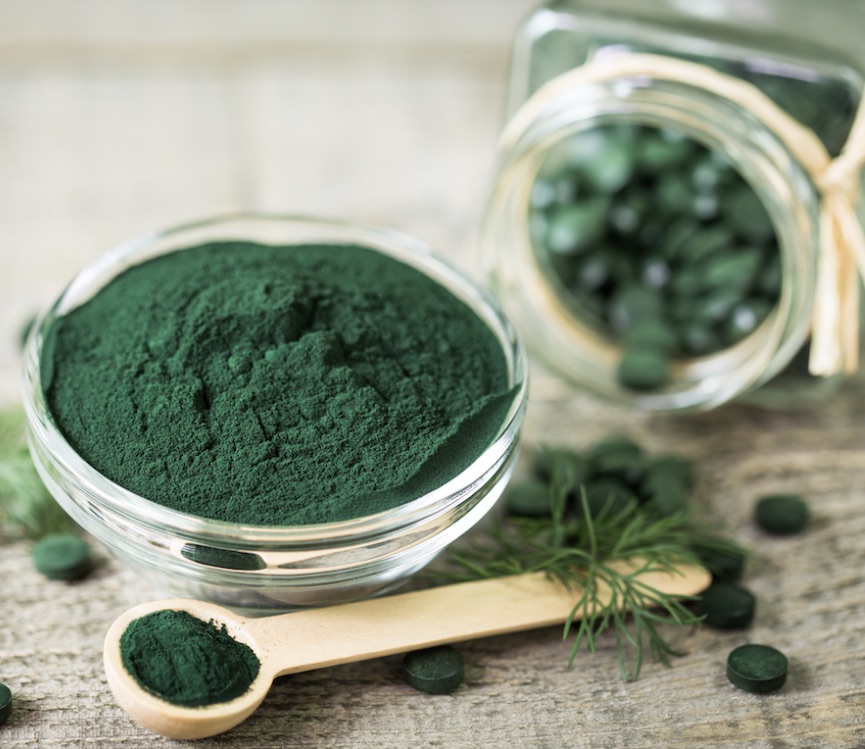 Spirulina is a microalgae that has been consumed for centuries due to its high nutritional value and supposed health benefits. It is rich in protein, that help protect cells from damage.
Spirulina is a microalgae that has been consumed for centuries due to its high nutritional value and supposed health benefits. It is rich in protein, that help protect cells from damage.
It is a true superfood, which is rich in vitamins and minerals, particularly beta-carotene, iron, calcium, and magnesium. It is considered a complete protein and a source of healthy fats.
It is a type of blue-green algae. Its green colour comes from chlorophyll, a detoxifying, oxygenating antioxidant found in all green plants, and its blue colour comes from phycocyanin, an anti-inflammatory antioxidant that has also been shown to increase the growth of stem cells. It is considered to be nature’s richest source of gamma-linolenic acid (GLA), a fatty acid that is helpful for improving skin, balancing the nervous system and the hormones, and in reducing inflammation.
But what does spirulina taste like ?
As it comes in deep-green colour, its taste is often described as “earthy with a slightly sulfuric edge” like the sea, or like a mouthful of lake water. Being a form of algae, the natural taste of this food source is not very pleasant and is quite similar to that of food products that are packed with chlorophyll. It has an acquired taste and gets growing on a person which tastes pleasant after a few gulps.
The two most common forms of available spirulina are powder and tablets. It’s also an ingredient in some protein and energy-boosting powder mixes. You can stir a small spoonful of spirulina powder into a glass of water or juice and drink it straight, or you can add some to a smoothie.The powder can add a gritty texture to what you’re eating or drinking .
Be warned: Just a small amount of deeply-pigmented spirulina will change the color of your drink into a deep blue-green, almost black. Keep a glass of water handy to prevent a blue-green teeth situation.
Mostly, fitness enthusiasts consume this product raw but there are several ways in which this superfood can be consumed. Along with smoothies, the taste of Spirulina is hardly noticed. In beverages and food products, the real earthy, sulfuric taste of it is hardly felt.
This tiny algae is packed with nutritions like ,
- Spirulina contains carbohydrates and is a rich source of protein, Tryptophan, Cystine, Aspartic acid, Glutamic acid, Proline, and Serine.
- It contains :
Vitamins – Vitamin B12 ,Folate, Riboflavin,Thiamine, Niacin, Vitamins C, D, E and K
Minerals- Calcium, Iron, Magnesium, Copper,Manganese, Phosphorus and Potassium
Spirulina Recipe Tips
- Spirulina Athletic’s Drink
Take some freshly squeezed lemons and add some coconut water in the mix. Add a pinch of sea salt and some sugar to the mixture. Then slowly add a tablespoon of Spirulina to the mix and stir this mixture gently. It will work as an instant energy drink after a heavy workout session.
- Spirulina Smoothie
Take a banana , a teaspoon of Organic Spirulina , a cup of nut milk, 1/2 avocado, a dash of cinnamon and a squeeze from a fresh lemon. Simply blend all ingredients in a blender. It will make you feel energized and will serve as a delicious alternative to just plain consumption of these algae.
- Spirulina Latte
It can be used as a pre yoga drink: mix 1/2 teaspoon in a glass of almond milk and add a sweetener of your choice (rice malt syrup). It will satiate you and revitalize without feeling heavy.
